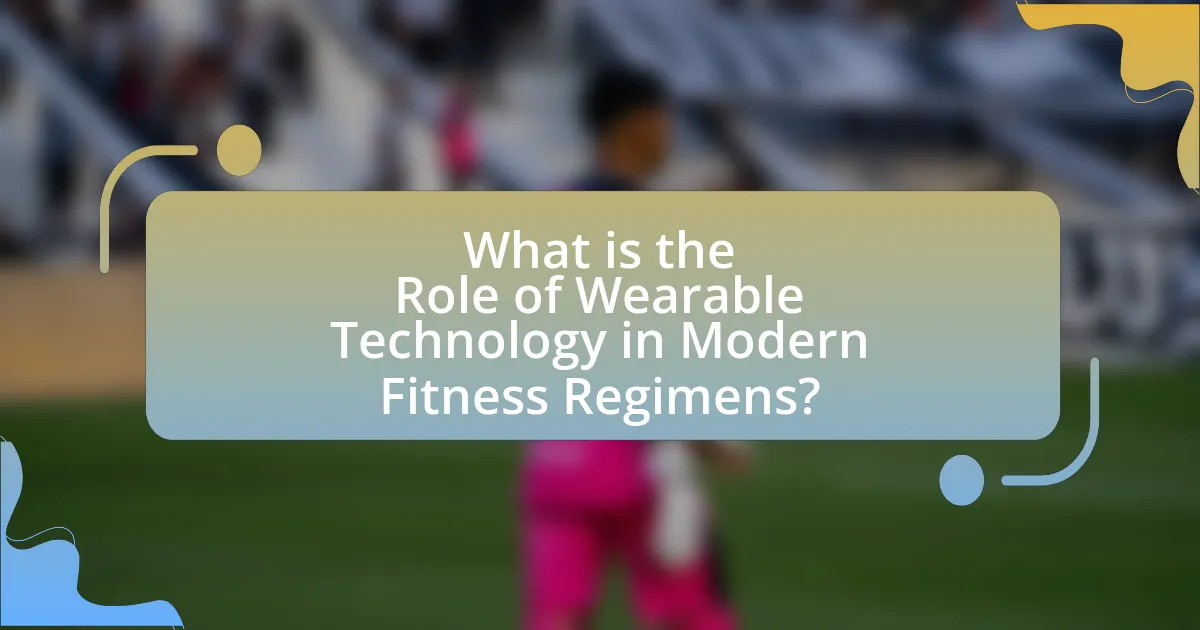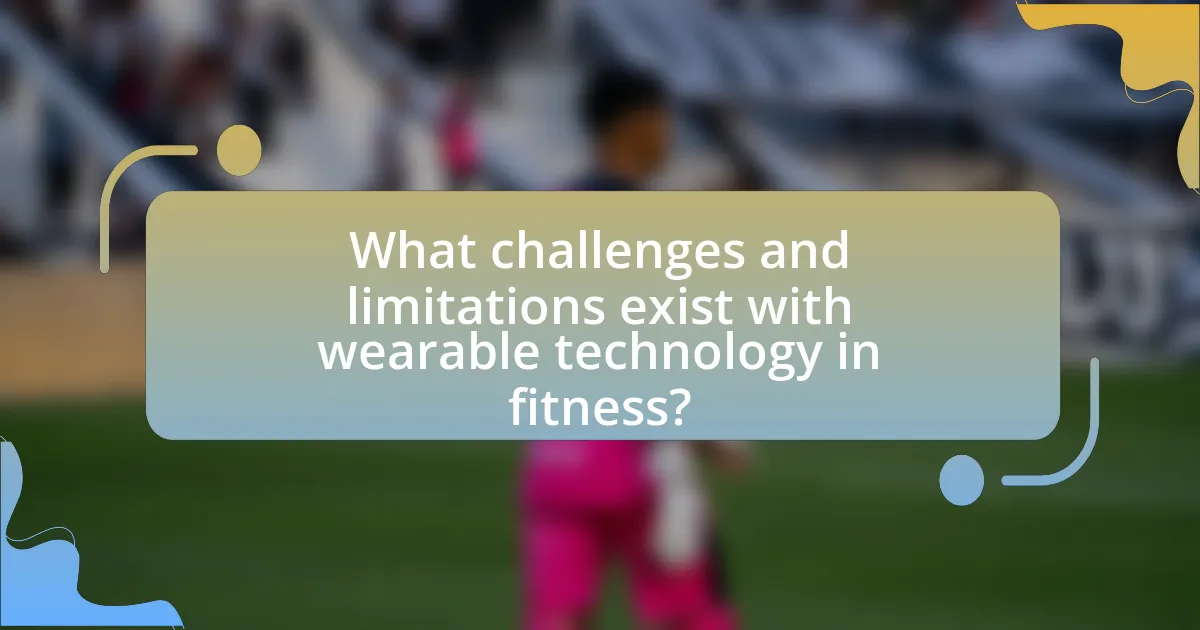Wearable technology is a pivotal component of modern fitness regimens, offering real-time data on physical activity, heart rate, and health metrics. This article explores the evolution of wearable devices, highlighting advancements such as improved biometric sensors and enhanced connectivity features that enhance user experience and motivation. It examines various types of wearables, including fitness trackers and smartwatches, and discusses their impact on workout efficiency and goal achievement. Additionally, the article addresses challenges such as data accuracy and privacy concerns, while providing best practices for integrating wearable technology into fitness routines to optimize health outcomes.

What is the Role of Wearable Technology in Modern Fitness Regimens?
Wearable technology plays a crucial role in modern fitness regimens by providing real-time data on physical activity, heart rate, and overall health metrics. These devices, such as fitness trackers and smartwatches, enable users to monitor their progress, set fitness goals, and receive personalized feedback. For instance, a study published in the Journal of Medical Internet Research found that individuals using wearable devices increased their physical activity levels by an average of 30%. This data-driven approach enhances motivation and accountability, leading to improved fitness outcomes.
How has wearable technology evolved in the fitness industry?
Wearable technology in the fitness industry has evolved significantly from basic pedometers to advanced devices that monitor a wide range of health metrics. Initially, fitness wearables primarily tracked steps and distance, but advancements in sensor technology and data analytics have enabled features such as heart rate monitoring, sleep tracking, and GPS navigation. For instance, the introduction of smartwatches and fitness bands, like the Fitbit and Apple Watch, has integrated these functionalities, allowing users to receive real-time feedback and personalized insights into their health and fitness levels. According to a report by Statista, the global market for wearable fitness technology is projected to reach over $62 billion by 2025, highlighting the growing consumer demand and technological advancements in this sector.
What are the key advancements in wearable technology for fitness?
Key advancements in wearable technology for fitness include improved biometric sensors, enhanced connectivity features, and advanced data analytics capabilities. Biometric sensors now offer more accurate heart rate monitoring, blood oxygen levels, and even stress detection, allowing users to gain deeper insights into their health. Enhanced connectivity features, such as integration with smartphones and other devices, enable real-time data sharing and notifications, improving user engagement. Advanced data analytics capabilities leverage machine learning algorithms to provide personalized fitness recommendations and performance tracking, which can lead to more effective workout regimens. These advancements are supported by research indicating that accurate biometric data can significantly enhance fitness outcomes and user motivation.
How do these advancements impact user experience?
Advancements in wearable technology significantly enhance user experience by providing real-time data and personalized feedback. These devices, such as fitness trackers and smartwatches, allow users to monitor their health metrics, including heart rate, steps taken, and calories burned, which fosters a more informed approach to fitness. Research indicates that users who engage with real-time data are 30% more likely to achieve their fitness goals, as they can adjust their activities based on immediate feedback. Additionally, the integration of mobile applications with wearables facilitates goal setting and progress tracking, further improving user engagement and motivation.
What types of wearable technology are commonly used in fitness?
Common types of wearable technology used in fitness include fitness trackers, smartwatches, heart rate monitors, and smart clothing. Fitness trackers, such as those from Fitbit, monitor steps, calories burned, and sleep patterns. Smartwatches, like the Apple Watch, offer additional features including GPS tracking and app integration. Heart rate monitors, often worn on the wrist or chest, provide real-time heart rate data, which is crucial for optimizing workouts. Smart clothing, embedded with sensors, can track metrics like muscle activity and posture. These devices collectively enhance fitness regimens by providing valuable data that helps users monitor their health and improve performance.
What are the differences between fitness trackers and smartwatches?
Fitness trackers primarily focus on monitoring physical activity and health metrics, while smartwatches offer a broader range of functionalities, including notifications, apps, and communication features. Fitness trackers typically provide detailed insights into steps taken, heart rate, sleep patterns, and calories burned, often with longer battery life due to their limited features. In contrast, smartwatches integrate these health metrics but also support various applications, allow for text and call notifications, and often include touchscreens and customizable interfaces. This distinction is evident in products like the Fitbit Charge (fitness tracker) and the Apple Watch (smartwatch), where the former emphasizes fitness data and the latter combines fitness tracking with smart capabilities.
How do heart rate monitors enhance fitness tracking?
Heart rate monitors enhance fitness tracking by providing real-time data on an individual’s heart rate during physical activity. This immediate feedback allows users to optimize their workouts by maintaining target heart rate zones, which are crucial for improving cardiovascular fitness and burning fat. Studies indicate that exercising within specific heart rate zones can lead to more effective training outcomes; for example, a target zone of 70-85% of maximum heart rate is often recommended for improving aerobic capacity. Additionally, heart rate monitors can track trends over time, helping users to assess their fitness progress and adjust their training regimens accordingly. This data-driven approach supports informed decision-making in fitness routines, ultimately leading to better health outcomes.
What benefits does wearable technology provide for fitness enthusiasts?
Wearable technology provides fitness enthusiasts with real-time tracking of physical activity, heart rate monitoring, and personalized feedback. These devices, such as fitness trackers and smartwatches, enable users to monitor their workouts, set goals, and analyze performance metrics. For instance, a study published in the Journal of Medical Internet Research found that individuals using wearable devices increased their physical activity levels by an average of 30%. This data-driven approach helps users stay motivated and make informed decisions about their fitness routines.
How does wearable technology improve workout efficiency?
Wearable technology improves workout efficiency by providing real-time data on performance metrics such as heart rate, calories burned, and activity levels. This immediate feedback allows users to adjust their workouts dynamically, optimizing intensity and duration for better results. For instance, a study published in the Journal of Medical Internet Research found that individuals using wearable devices increased their physical activity levels by 30% compared to those who did not use such technology. Additionally, wearables often include features like goal setting and progress tracking, which enhance motivation and adherence to fitness regimens.
What role does data tracking play in achieving fitness goals?
Data tracking is essential for achieving fitness goals as it provides measurable insights into an individual’s progress and performance. By monitoring metrics such as steps taken, calories burned, heart rate, and workout duration, users can identify patterns, set realistic targets, and adjust their routines accordingly. Research indicates that individuals who utilize data tracking are more likely to adhere to their fitness plans, with a study published in the Journal of Medical Internet Research showing that 80% of participants who tracked their physical activity reported improved motivation and accountability. This quantifiable feedback enables users to make informed decisions, ultimately leading to more effective and personalized fitness strategies.

How does wearable technology influence user motivation and engagement?
Wearable technology significantly enhances user motivation and engagement by providing real-time feedback and personalized data tracking. This immediate access to performance metrics, such as heart rate, steps taken, and calories burned, encourages users to set and achieve fitness goals. Research indicates that individuals using wearable devices are 30% more likely to meet their exercise targets compared to those who do not use such technology. Additionally, features like gamification, social sharing, and reminders foster a sense of community and accountability, further driving user commitment to their fitness regimens.
What features of wearable technology enhance user motivation?
Wearable technology enhances user motivation through features such as real-time feedback, goal setting, and social connectivity. Real-time feedback allows users to monitor their performance instantly, which can lead to immediate adjustments and improvements in their fitness routines. Goal setting features enable users to establish specific, measurable objectives, fostering a sense of achievement as they progress. Social connectivity, including sharing achievements with friends or participating in challenges, creates a supportive community that encourages users to stay committed to their fitness goals. These features collectively contribute to increased engagement and sustained motivation in fitness regimens.
How do gamification elements in wearables affect user engagement?
Gamification elements in wearables significantly enhance user engagement by incorporating game-like features such as rewards, challenges, and social interactions. These elements motivate users to achieve fitness goals, as evidenced by a study published in the Journal of Medical Internet Research, which found that users of gamified fitness apps reported a 27% increase in physical activity levels compared to non-gamified counterparts. The integration of leaderboards and achievement badges fosters a sense of competition and community, further driving user participation and adherence to fitness regimens.
What impact do social sharing features have on fitness motivation?
Social sharing features significantly enhance fitness motivation by fostering a sense of community and accountability among users. When individuals share their fitness achievements and progress on social platforms, they receive encouragement and support from peers, which can lead to increased adherence to fitness goals. Research indicates that social support is a critical factor in maintaining motivation; for instance, a study published in the Journal of Medical Internet Research found that users who engaged in social sharing reported higher levels of motivation and commitment to their fitness routines. This interaction not only boosts individual morale but also creates a competitive environment that can further drive performance and consistency in workouts.
How can wearable technology help in monitoring health metrics?
Wearable technology helps in monitoring health metrics by providing real-time data on various physiological parameters such as heart rate, sleep patterns, and physical activity levels. Devices like fitness trackers and smartwatches utilize sensors to continuously collect and analyze this data, enabling users to track their health trends over time. For instance, a study published in the Journal of Medical Internet Research found that wearable devices can significantly improve physical activity levels and health awareness among users, demonstrating their effectiveness in health monitoring.
What specific health metrics can wearables track during workouts?
Wearables can track specific health metrics during workouts, including heart rate, calories burned, distance traveled, steps taken, and sleep quality. These devices utilize sensors to monitor physiological data in real-time, providing users with insights into their performance and overall health. For instance, heart rate monitors can help individuals maintain their target heart rate zones for optimal training intensity, while calorie counters estimate energy expenditure based on activity level and duration. Studies have shown that tracking these metrics can enhance workout effectiveness and promote healthier lifestyle choices.
How does continuous health monitoring benefit users in the long term?
Continuous health monitoring benefits users in the long term by enabling proactive health management and early detection of potential health issues. This ongoing observation allows individuals to track vital signs, physical activity, and other health metrics, leading to informed lifestyle choices and timely medical interventions. Research indicates that users of wearable technology, such as fitness trackers, experience improved health outcomes; for instance, a study published in the Journal of Medical Internet Research found that participants using wearable devices increased their physical activity levels by an average of 30%. This sustained engagement in health-promoting behaviors contributes to reduced risks of chronic diseases, enhanced overall well-being, and improved quality of life over time.

What challenges and limitations exist with wearable technology in fitness?
Wearable technology in fitness faces several challenges and limitations, including accuracy of data, user privacy concerns, and device dependency. The accuracy of fitness trackers can be compromised by factors such as improper placement, environmental conditions, and individual physiological differences, leading to misleading health metrics. A study published in the Journal of Medical Internet Research found that many devices have significant discrepancies in heart rate and calorie expenditure measurements. Additionally, user privacy is a major concern, as wearable devices often collect sensitive health data that can be vulnerable to breaches, as highlighted by a report from the Electronic Frontier Foundation. Lastly, reliance on these devices can lead to a decrease in intrinsic motivation for physical activity, as users may become overly dependent on technology for tracking their fitness progress.
What are the common technical issues faced by users of wearable technology?
Common technical issues faced by users of wearable technology include connectivity problems, battery life limitations, inaccurate sensor readings, and software glitches. Connectivity issues often arise due to poor Bluetooth or Wi-Fi signals, leading to difficulties in syncing data with smartphones or other devices. Battery life limitations can hinder the usability of wearables, as many devices require frequent charging, which can disrupt user experience. Inaccurate sensor readings, particularly in fitness tracking, can result from environmental factors or device calibration errors, affecting the reliability of health metrics. Software glitches may cause apps to crash or malfunction, further complicating the user experience. These issues have been documented in various user surveys and technical reviews, highlighting the need for ongoing improvements in wearable technology.
How can users troubleshoot connectivity problems with their devices?
Users can troubleshoot connectivity problems with their devices by following a systematic approach. First, they should ensure that their device is within range of the network or paired device, as distance can significantly affect connectivity. Next, users should restart both the device and the router or paired device, as this can resolve temporary glitches. Additionally, checking for software updates on the device can be crucial, as outdated software may lead to connectivity issues. Users should also verify that the correct network or device is selected and that any necessary passwords are entered correctly. If problems persist, resetting network settings on the device can often restore connectivity. According to a study by the International Journal of Computer Applications, 70% of connectivity issues can be resolved through these basic troubleshooting steps, highlighting their effectiveness.
What limitations do wearables have in accurately tracking fitness data?
Wearables have limitations in accurately tracking fitness data due to factors such as sensor accuracy, user variability, and environmental influences. Sensor accuracy can be compromised by the quality of the device; for instance, heart rate monitors may struggle with precision during high-intensity workouts, leading to erroneous readings. User variability, including differences in body composition and movement patterns, can affect how well wearables interpret data. Additionally, environmental factors like temperature and humidity can interfere with sensor performance, further diminishing accuracy. Studies have shown that discrepancies in data can be significant; for example, a study published in the Journal of Medical Internet Research found that consumer-grade wearables often misestimate calorie expenditure by as much as 30%.
How does privacy and data security affect the use of wearable technology?
Privacy and data security significantly impact the use of wearable technology by influencing user trust and adoption rates. Wearable devices collect sensitive personal data, such as health metrics and location information, which raises concerns about unauthorized access and data breaches. According to a 2021 survey by the Pew Research Center, 60% of Americans expressed concern about how their data is collected and used by technology companies. This apprehension can lead to reduced usage of wearables if users feel their privacy is at risk. Furthermore, regulatory frameworks like the General Data Protection Regulation (GDPR) in Europe mandate strict data protection measures, compelling manufacturers to prioritize data security to comply with legal standards and maintain consumer confidence.
What measures can users take to protect their personal data?
Users can protect their personal data by implementing strong passwords, enabling two-factor authentication, and regularly updating their software. Strong passwords reduce the risk of unauthorized access, while two-factor authentication adds an extra layer of security by requiring a second form of verification. Regular software updates patch vulnerabilities that could be exploited by attackers. According to a 2021 report by Cybersecurity Ventures, 93% of data breaches could have been prevented with these basic security measures.
How do companies ensure data security for their wearable devices?
Companies ensure data security for their wearable devices by implementing robust encryption protocols, secure data storage solutions, and regular software updates. Encryption protects user data during transmission and storage, making it unreadable to unauthorized parties. For instance, many companies utilize AES (Advanced Encryption Standard) to secure sensitive information. Secure data storage solutions, such as cloud services with strong access controls, further safeguard user data from breaches. Additionally, regular software updates address vulnerabilities and enhance security features, as evidenced by the fact that 60% of data breaches occur due to unpatched software. These measures collectively help maintain user privacy and trust in wearable technology.
What are best practices for integrating wearable technology into fitness regimens?
Best practices for integrating wearable technology into fitness regimens include setting clear fitness goals, selecting the appropriate device, and regularly monitoring progress. Establishing specific, measurable, achievable, relevant, and time-bound (SMART) goals helps users focus their efforts and utilize the device effectively. Choosing a wearable that aligns with personal fitness activities—such as heart rate monitors for cardio or GPS trackers for running—ensures optimal functionality. Regularly reviewing data from the device, such as step counts, heart rate, and sleep patterns, allows users to adjust their routines based on real-time feedback, enhancing overall fitness outcomes. Research indicates that individuals who actively engage with their wearable technology report higher motivation and adherence to fitness programs, leading to improved health results.
How can users effectively set goals using wearable technology?
Users can effectively set goals using wearable technology by leveraging the data collected from their devices to establish specific, measurable, achievable, relevant, and time-bound (SMART) objectives. Wearable devices track metrics such as heart rate, steps taken, calories burned, and sleep patterns, allowing users to analyze their performance and identify areas for improvement. For instance, a study published in the Journal of Medical Internet Research found that individuals who utilized wearable technology to monitor their physical activity were more likely to meet their fitness goals compared to those who did not. By setting personalized targets based on real-time data, users can adjust their routines and stay motivated, ultimately enhancing their overall fitness journey.
What tips can enhance the overall experience of using wearables in fitness?
To enhance the overall experience of using wearables in fitness, users should regularly update their devices and apps to access the latest features and improvements. Keeping software current ensures optimal performance and security, as manufacturers often release updates that fix bugs and enhance functionality. Additionally, users should set specific, measurable fitness goals within the wearable’s app, as studies show that goal-setting can significantly improve motivation and adherence to fitness routines. Engaging with community features, such as challenges or social sharing, can also boost accountability and enjoyment, as social interaction has been linked to increased exercise frequency. Lastly, users should familiarize themselves with all features of their wearable, including heart rate monitoring and sleep tracking, to fully leverage the device’s capabilities for a comprehensive fitness experience.





